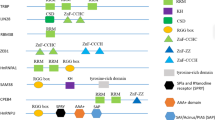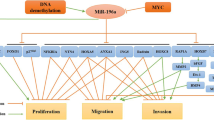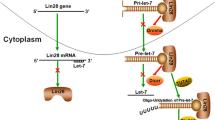Abstract
TARBP2 is a RNA-binding protein (RBP) involved in miRNA processing and maturation. TARBP2 plays significant roles in many biological and pathological conditions, including viral expression of HIV-1, microsatellite instability, cancer stem cell properties, and tumor progression. Overexpression of TARBP2 was observed in many cancers such as prostate cancer, cutaneous malignant melanoma, and adrenocortical carcinoma. In addition, TARBP2 was also found to be downregulated in some cancers including colorectal cancer, gastric cancer, Ewing sarcoma, and upper urinary tract urothelial carcinoma. Therefore, whether TARBP2 functions as the tumor suppressor or tumor promoter is conflicting. In the present review, we provide an overview of current knowledge concerning the role of TARBP2 in tumor development and progression.
Similar content being viewed by others
Avoid common mistakes on your manuscript.
Introduction
TARBP2, abbreviation of trans-activation-responsive-RNA-binding protein 2, is a double-stranded RNA-binding protein (RBP) implicated in microRNA processing [1–3]. TARBP2 gene encodes TRBP, which is an essential functional partner of DICER1 and loads short RNAs into the RNA-induced silencing complex (RISC) [4–6]. TARBP2 plays significant roles in many biological and pathological conditions, including viral expression of HIV-1, microsatellite instability, cancer stem cell properties, and tumor progression [7–10]. Expression of TARBP2 varied in different cancer cell lines and plays different roles in these cancer cells. Overexpression of TARBP2 was observed in many cancers, including prostate cancer [11], cutaneous malignant melanoma metastases [12], and adrenocortical carcinoma [8]. TARBP2 was downregulated in some cancers, such as colorectal cancer [1], gastric cancer [13], Ewing sarcoma [10], and upper urinary tract urothelial carcinoma [9]. Therefore, the reports about TARBP2 as the tumor suppressor or tumor promoter are conflicting.
Molecular characterization and biological functions of TARBP2
TARBP2 is a RNA-binding protein involved in miRNA processing and maturation [14]. By interacting directly with the DICER1 protein, TARBP2 is required for the stabilization of the DICER1 protein [4, 6]. Therefore, it is an integral member of a DICER1-containing complex. TARBP2 binds the sRSE family and similar structural elements—collectively termed TARBP2-binding structural elements (TBSEs) in transcripts [15].
Deregulations of TARBP2 in human cancers
Breast cancer
Lin et al. found that cytoplasm expression levels of TARBP2 were significantly higher in breast carcinoma than in normal breast tissues (NBT) [16]. Further investigation showed that cytoplasm TARBP2 expression was positively correlated to triple-negative breast cancer (TNBC) and stage III breast cancer. Moreover, TARBP2 expression level was the highest in TNBC, higher than that of non-TNBC and their adjacent NBT. In addition, TARBP2 served as an independent poor prognostic factor for breast cancer. TARBP2 was upregulated in metastatic human breast tumors and overexpression of TARBP2 promoted metastatic breast cancer cell colonization and invasion [15]. In addition, amyloid precursor protein (APP) and transcription factor ZNF395 transcripts, which were associated with Alzheimer’s and Huntington’s disease, were destabilized by TARBP2 in cancer cells. The cleavage product of APP directly inhibited cancer cell invasion while ZNF395 decreased gene expression program of a pro-metastatic. Therefore, TARBP2 can govern cancer progression through regulating RNA destabilization of mRNA structural elements. Therefore, TARBP2 might play an oncological role in breast cancer.
Melanoma
Sand et al. detected that TARBP2 were significantly upregulated in benign melanocytic nevi (BMN) compared to primary cutaneous malignant melanoma (PCMM) [12]. In addition, TARBP2 expression levels were significantly higher in cutaneous malignant melanoma metastases (CMMM) than PCMM. The miRNA machinery components TARBP2 were deregulated in PCMM and CMMM compared to BMN, indicating that it played a role in the initiation and progression of malignant transformation.
Diffuse large B cell lymphoma
The expression of TARBP2 was significantly higher in de novo diffuse large B cell lymphomas (DLBCLs) than with lymph nodes (LN) [17]. In addition, decreased expression of TARBP2 was observed in transformed compared with de novo cases. DLBCL patients with higher TARBP2 expression responded a poorer to chemotherapy, indicating that TARBPs served as a prognostic biomarker for chemotherapy. Furthermore, inhibition of TARBP2 decreased cell growth and increases apoptosis in DLBCL cell lines. In conclusion, TARBP2 played an oncological role in regulating miRNA processing efficiency in DLBCLs.
Adrenocortical carcinoma
The expression level of TARBP2 was significantly elevated in the adrenocortical carcinomas compared with adenomas or normal adrenal cortices [8]. Furthermore, mRNA expression levels of TARBP2 can strongly discriminate carcinomas from adenomas. Functional study further demonstrated that inhibition of TARBP2 expression decreased cell proliferation and promoted apoptosis in adrenocortical carcinoma (ACC) cells. Although TARBP2 overexpression in ACC was not related to the TARBP2 gene mutations, copy number gain was identified in more than 50 % of the carcinomas. Furthermore, miR-195 and miR-497 could directly regulate TARBP2 expression in ACC cells. However, TARBP2 expression did not correlate with histopathological and clinical parameters in ACC patients [6]. In summary, TARBP2 acted as a tumor suppressor in ACC.
Gastrointestinal cancers
Microsatellite-instable (MSI) tumors display DNA mismatch repair deficiency, leading to the accumulation mutations of insertion and/or deletion [18]. TARBP2 mutations decreased TRBP protein expression, resulting in increased cellular transformation through miRNA processing impairment. The TRBP impairment also led to a defect in DICER1 activity. Truncating heterozygous mutations in TARBP2 were observed in primary sporadic and hereditary MSI + gastrointestinal cancers (GI cancers) [4]. TARBP2 mutations might be the underlying mechanism of overall miRNA decrease in a subset of MSI + cancers. To conclude, TARBP2 played a tumor suppressive role in GI cancers. The reintroduction of TRBP might inhibit GI cancer cell growth cancers by the restoration of miRNA production, providing a novel insight for the development of treatment of cancer.
Colorectal cancers
Mutation rates in hereditary nonpolyposis colorectal cancers (HNPCC) were higher (13 out of 30) than in sporadic colorectal (53 out of 209) or gastric (6 out of 43) cancers, while no mutations existed in microsatellite-stable colorectal cancers, normal colon, or lymphocytes from individuals with HNPCC [4]. However, Garre et al. found a significantly lower incidence of TARBP2 frameshift mutations (1.75 %) than that reported by Melo et al. (43.3 %) [1]. The different incidence of TARBP2 somatic mutations in MSI-HNPCC tumors between two studies may be due to some ill-defined clinical and/or molecular features. Further analyses in larger sample size are required to define a definite incidence of TARBP2 mutations in MSI-HNPCC tumors.
Upper urinary tract urothelial carcinoma
Microsatellite instability (MSI) plays significant roles in the pathogenesis of upper urinary tract urothelial carcinomas (UUT-UCs) [9, 18, 19]. As mentioned above, truncating mutations of TARBP2 existed in MSI tumors in the gastrointestinal tract. HNPCC (13 of 30) also demonstrated higher mutation rates than sporadic colorectal (53 of 209) or gastric (6 of 43) carcinomas, while microsatellite-stable colorectal carcinoma, benign colonic mucosa, or lymphocytes from patients with HNPCC showed no mutations [9]. Therefore, TARBP2 might be a novel target gene of MSI, with its coding repeat sequences accumulating insertion and/or deletion under positive selection during tumor progression. High MSI (MSI-H) status was found in all of the tumors in 132 UUT-UCs patients. However, no truncating mutation of TARBP2 was observed in the four cases of MSI-H UUT-UCs. This might due to the limited sample size or the nature of tumor. Further investigations are warranted to confirm the results in a larger sample size.
Ewing sarcoma
The miRNA profile of Ewing sarcoma family tumor (ESFT) CSCs showed a repression of a wide range of miRNAs, which was shared by embryonic stem cells and CSCs from various cancer types [10]. In addition, ESFT CSCs demonstrated decreased expression of TARBP2 [10]. Therefore, the universal decreased miRNAs in ESFT CSCs was due to reversible disruption of TARBP2-dependent miRNA maturation. Moreover, restored expression of TARBP2 inhibited clonogenicity and tumor growth of ESFT CSC in mice in vivo. Therefore, deregulation of TARBP2-dependent miRNA expression was involved in the CSC tumor maintenance and self-renewal. Since TARBP2-dependent microRNA maturation played crucial roles in the emergence of CSC, Buros et al. assessed the effect of combining a drug with standard therapy in an ESFT [20]. Enoxacin can promote miRNA maturation by increasing TARBP2 function, increasing apoptosis but only in ESFT spheres. In combination, the drugs significantly decreased CSCs and reduced primary ESFTs in xenograft assays. In conclusion, a combination of mechanism-based targeting of CSC with a standard-of-care cytotoxic drug might serve as a potentially therapeutic strategy for ESFT.
Other types of cancers
No TARBP2 mutation existed in prostate cancer cell lines. All of the five prostate cancer cell lines were wild type for the TARBP2 gene and expressed TRBp protein [11]. Furthermore, primary prostate carcinomas displayed normal levels of TRBp protein. Wilms’ tumor (WT) is the most common pediatric kidney cancer, affecting 1/10,000 children worldwide. Point mutations were identified TARBP2 in WT, indicating that impaired miRNA biogenesis plays a crucial role in WT [21] (Table 1).
Mechanisms of deregulated TARBP2 in tumors
TARBP2 mutations cause diminished TRBP protein expression and are associated with a destabilization of the DICER1 protein [4]. TARBP2 mutations lead to overall miRNA downregulation in tumors since it results in a defect in the miRNA processing. The reintroduction of TRBP inhibits tumor growth through restoring the biogenesis of miRNAs.
Conclusion
Accumulating evidences have demonstrated that expression levels of TARBP2 were frequently deregulated in various human tumors. The present studies summarized the studies relating to deregulated TARBP2 and human cancers, such as breast cancer, DLBCL, melanoma, and ESFT CSCs. Moreover, functional studies further revealed that TARBP2 played an oncogenic or tumor suppressor role in many tumors both in vitro and in vivo. TARBP2 gene mutations were found in several tumors such as HNPCC, (MSI) + GI cancers, and WT, involving in the deregulations of TARBP2. In other tumors, no mutations of TARBP2 were observed, including MSI-H UUT-UCs, ACC, and prostate cancer. Decreased expression of TARBP2 resulted in a wide range decrease of miRNAs in human cancers. Further investigations are required to investigate the underlying molecular mechanisms of TARBP2 in human cancers. Moreover, future studies should be conducted to investigate the application of TARBP2 as diagnostic/or therapeutic biomarker for tumor.
References
Garre P, Perez-Segura P, Diaz-Rubio E, Caldes T, de la Hoya M. Reassessing the TARBP2 mutation rate in hereditary nonpolyposis colorectal cancer. Nat Genet. 2010;42:817–8. author reply 818.
Zimmermann J, Latta L, Beck A, Leidinger P, Fecher-Trost C, Schlenstedt G, et al. Trans-activation response (TAR) RNA-binding protein 2 is a novel modulator of transient receptor potential canonical 4 (TRPC4) protein. J Biol Chem. 2014;289:9766–80.
Bannwarth S, Talakoub L, Letourneur F, Duarte M, Purcell DF, Hiscott J, et al. Organization of the human tarbp2 gene reveals two promoters that are repressed in an astrocytic cell line. J Biol Chem. 2001;276:48803–13.
Melo SA, Ropero S, Moutinho C, Aaltonen LA, Yamamoto H, Calin GA, et al. A TARBP2 mutation in human cancer impairs microRNA processing and DICER1 function. Nat Genet. 2009;41:365–70.
Sand M, Skrygan M, Georgas D, Arenz C, Gambichler T, Sand D, et al. Expression levels of the microRNA maturing microprocessor complex component DGCR8 and the RNA-induced silencing complex (RISC) components argonaute-1, argonaute-2, PACT, TARBP1, and TARBP2 in epithelial skin cancer. Mol Carcinog. 2012;51:916–22.
de Sousa GR, Ribeiro TC, Faria AM, Mariani BM, Lerario AM, Zerbini MC, Soares IC, Wakamatsu A, Alves VA, Mendonca BB, Fragoso MC, Latronico AC, Almeida MQ. Low DICER1 expression is associated with poor clinical outcome in adrenocortical carcinoma. Oncotarget. 2015.
Kozak CA, Gatignol A, Graham K, Jeang KT, McBride OW. Genetic mapping in human and mouse of the locus encoding TRBP, a protein that binds the TAR region of the human immunodeficiency virus (HIV-1). Genomics. 1995;25:66–72.
Caramuta S, Lee L, Ozata DM, Akcakaya P, Xie H, Hoog A, et al. Clinical and functional impact of TARBP2 over-expression in adrenocortical carcinoma. Endocr Relat Cancer. 2013;20:551–64.
Bai S, Nunez AL, Wei S, Ziober A, Yao Y, Tomaszewski JE, et al. Microsatellite instability and TARBP2 mutation study in upper urinary tract urothelial carcinoma. Am J Clin Pathol. 2013;139:765–70.
De Vito C, Riggi N, Cornaz S, Suva ML, Baumer K, Provero P, et al. A TARBP2-dependent miRNA expression profile underlies cancer stem cell properties and provides candidate therapeutic reagents in Ewing sarcoma. Cancer Cell. 2012;21:807–21.
Sousa E, Graca I, Baptista T, Vieira FQ, Palmeira C, Henrique R, et al. Enoxacin inhibits growth of prostate cancer cells and effectively restores microRNA processing. Epigenetics. 2013;8:548–58.
Sand M, Skrygan M, Georgas D, Sand D, Gambichler T, Altmeyer P, et al. The miRNA machinery in primary cutaneous malignant melanoma, cutaneous malignant melanoma metastases and benign melanocytic nevi. Cell Tissue Res. 2012;350:119–26.
Kim MS, Oh JE, Kim YR, Park SW, Kang MR, Kim SS, et al. Somatic mutations and losses of expression of microRNA regulation-related genes AGO2 and TNRC6A in gastric and colorectal cancers. J Pathol. 2010;221:139–46.
Zhong J, Peters AH, Lee K, Braun RE. A double-stranded RNA binding protein required for activation of repressed messages in mammalian germ cells. Nat Genet. 1999;22:171–4.
Goodarzi H, Zhang S, Buss CG, Fish L, Tavazoie S, Tavazoie SF. Metastasis-suppressor transcript destabilization through TARBP2 binding of mRNA hairpins. Nature. 2014;513:256–60.
Lin X, Wu M, Liu P, Wei F, Li L, Tang H, et al. Up-regulation and worse prognostic marker of cytoplasmic TARBP2 expression in obstinate breast cancer. Med Oncol. 2014;31:868.
Caramuta S, Lee L, Ozata DM, Akcakaya P, Georgii-Hemming P, Xie H, et al. Role of microRNAs and microRNA machinery in the pathogenesis of diffuse large B-cell lymphoma. Blood Cancer J. 2013;3:e152.
Yamamoto H, Imai K. Microsatellite instability: an update. Arch Toxicol. 2015;89:899–921.
Audenet F, Yates DR, Cussenot O, Roupret M. The role of chemotherapy in the treatment of urothelial cell carcinoma of the upper urinary tract (UUT-UCC). Urol Oncol. 2013;31:407–13.
Cornaz-Buros S, Riggi N, DeVito C, Sarre A, Letovanec I, Provero P, et al. Targeting cancer stem-like cells as an approach to defeating cellular heterogeneity in Ewing sarcoma. Cancer Res. 2014;74:6610–22.
Torrezan GT, Ferreira EN, Nakahata AM, Barros BD, Castro MT, Correa BR, et al. Recurrent somatic mutation in DROSHA induces microRNA profile changes in Wilms tumour. Nat Commun. 2014;5:4039.
Acknowledgments
This work was supported by grants from the National Natural Science Foundation of China (NSFC) (Grant Number: 81401847).
Author information
Authors and Affiliations
Corresponding author
Additional information
Xin Yu and Zheng Li contributed equally to this work.
Rights and permissions
About this article
Cite this article
Yu, X., Li, Z. The role of TARBP2 in the development and progression of cancers. Tumor Biol. 37, 57–60 (2016). https://doi.org/10.1007/s13277-015-4273-6
Received:
Accepted:
Published:
Issue Date:
DOI: https://doi.org/10.1007/s13277-015-4273-6




